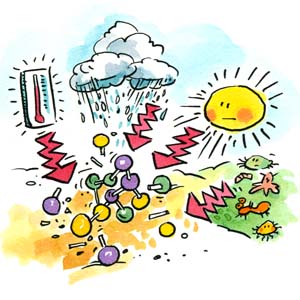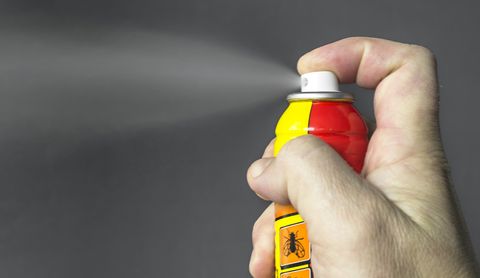What is DEET?
When we think about bug and insect bites, our first thought might not be to jump to DEET. So many people are using bug and insect spray but they don’t really understand the ingredients that go into the spray bottle. The main component in bug spray is DEET. DEET (chemical name N, N-diethyl-meta-toulamide) is used as the active ingredient in most insect repellents. A common misconception with bug spray is that the spray actually kills the insect, but in fact DEET is designed to repel insects rather than kill them. [1] DEET is used for the direct application on to peoples skin in the forms of lotions, liquids, sprays, and more.
Figure 1: Show a commonly used bug spray that contains DEET. [2]
Now that we have a better understanding of what DEET is, lets look into the mechanism of action, toxicity, and target organs associated with DEET.
Figure 2: Chemical Structure of DEET [3]
The mechanism(s) of action by which the insects are repelled and how humans are affects by DEET is still unknown and being continuously studied. The suggested mechanism of action in how DEET repels insects is that the chemical in DEET blocks the olfactory receptors of insects to the “smell” of human sweat and breath [4].The mechanism of action associated with human exposure is poorly understood. A recent study suggested that DEET is capable of blocking the human Na+ and K+ channels in the rat animal model [5]. This blocking of the channels leads to neuro-sensory adverse effects experienced (ex: numbness or tingling of extremities).
DEET is commonly employed as a liquid that is applied to the human skin. DEET is absorbed quickly through the skin and 48% of the applied dose is absorbed within 6 hours [6]. The toxicity of DEET is related to concentration levels of the applied chemical. Once DEET is in the body, it is broken down by the liver and eliminated from the body, mainly through urine. Nearly all of DEET that is taken in from the skin is eliminated by the body within 24 hours of applying it [7].
There has been research performed on the incidence of cancer development while using DEET and the increased risk of birth defects. Studies have shown there is no relation to cancer development or birth defects with the use of DEET. There has been information that has shown that children are more sensitive to DEET than adults.
Another way that DEET can be exposed to humans and wildlife is through the soil. DEET can be released into the soil during administration. Once in the soil, DEET is broken down by man microbes. DEET found in the soil can spread to waste water and into other bodies of water [6]. There have been studies to show this does not lead to any dangerous levels of toxicity in humans and wildlife.
Figure 2: DEET spreading to soil [7].

Exposure of DEET has been associated with a variety of health effects that include neurological, respiratory, cardiovascular, GI, dermal, and ocular [8]. There have been limited reports of serious health effects associated with DEET, even though there are millions of applications a year. Some adverse effects of DEET reported are seizures, restlessness, impaired cognitive function, and hyperextension of muscles [8]. More common adverse effects reported are skin irritation and watering of the eyes.
Figure 3: Spraying of bug spray [9].
Treatment of DEET poisoning must be performed immediately after exposure. Ocular exposure of DEET should be irrigated with water for~15 minutes and any skin exposure should be washed with soap and water. Most serious DEET poisoning will be treated with supportive therapies, including but not limited to seizure medication, anti-emetics, IV’s, and antihistamines. There is no specific treatment for DEET poison at the this time.
Now that we have a full understanding of DEET, lets look at a brief history of it. DEET was actually developed by the U.S army in 1946 for protection of the soldiers in infect infected areas. This was due to the lack of medical treatment for insect based diseases, such as malaria. Another interesting fact about DEET is that the EPA classifies DEET as “Group D”. This means that DEET is not classified as a human carcinogen.
I believe that DEET is a good pesticide to use, as long as we are using it carefully. Even with all the information and data available, there are still ongoing studies to examine the effects of DEET. I assume this is because it is a commonly used pesticide in every day life. Hopefully this blog allows you to take a closer look into DEET.
References
[1] https://www.cdc.gov/malaria/toolkit/DEET.pdf
[2] https://www.amazon.com/Repel-Insect-Repellent-Single-Bottle/dp/B004H89KFC
[3] https://www.researchgate.net/figure/DEET-chemical-structure_fig1_326381078
[4]Ditzen M, Pellegrino M, Vosshall LB: Insect odorant receptors are molecular targets of the insect repellent DEET. Science. 2008 Mar 28;319(5871):1838-42. doi: 10.1126/science.1153121. Epub 2008 Mar 13. [PubMed:18339904]
[5]Swale DR, Sun B, Tong F, Bloomquist JR: Neurotoxicity and mode of action of N, N-diethyl-meta-toluamide (DEET). PLoS One. 2014 Aug 7;9(8):e103713. doi: 10.1371/journal.pone.0103713. eCollection 2014. [PubMed:25101788]
[6]IPCS INCHEM: DEET Profile [Link]
[7]http://npic.orst.edu/factsheets/DEETgen.html
[8] https://www.atsdr.cdc.gov/toxprofiles/tp185-c2.pdf
[9] https://www.menshealth.com/trending-news/a19513661/what-is-kd-drug-bug-spray/



If you are comfortable applying chemicals to your body DEET will work, for mosquitoes and other insects. As the epidemic of tick-borne disease continues, and Lyme is joined by other threats such as Powassan virus, Hearland virus, and Rocky Mountain spotted fever, it is best the public understand that DEET is not a tick repellent. We find DEET reasonably safe, and it will work fairly well for biting insects. https://www.tickproofrepellent.com/